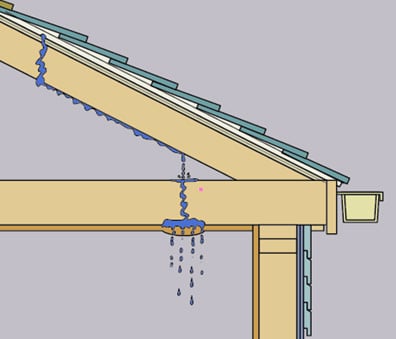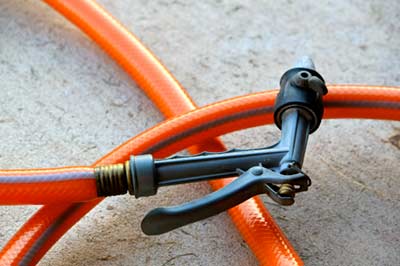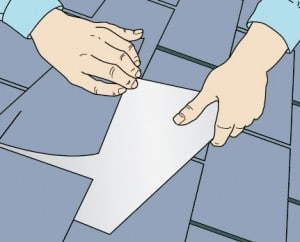I found this expert advice from hometips.com that I hope will be of help to others too:
The source of most roof leaks is hard to find because it originates away from where the leak shows up. In order to find the source of a leak, follow a roofer’s advice and “think like water.”
Water typically comes in through worn, broken, or missing shingles; where nails have worked loose; or through corroded or poorly sealed roof flashing around vents, skylights, or chimneys or along the intersections of roof planes.

A roof leak often travels down a rafter, showing up down-roof from where it begins.
Look for a roof leak during the day. Go into the attic with a bright flashlight; step only on secure framing members and never on the insulation or topside of the ceiling below—neither of these will support you! Start above the place where the drip has occurred and work your way uproof, looking for wetness along the framing members.
If the weather has been dry for a while, look for water marks, stains, or discolorations on the wood made by moisture. Then switch off the light and try to find a hole where daylight shows through the roof. (With a wood-shingle roof, you’ll see many such places, but while the overlapped shingles let light show through they shed water.) If it’s still raining, put a bucket under the leak in an area with proper support. Let the bucket collect the drips and fix the leak when the weather clears.

Use a garden hose with nozzle control to water-test for roof leaks.
Water-Testing for Roof Leaks
If you can’t find the cause of a leak from the attic or by visual inspection on the roof surface, wait for dry weather and ask a friend to help you do a water test. To do this, one person goes onto the roof with a garden hose; the other person goes inside the attic with a bucket and a strong light.The person in the attic watches carefully while the one on the roof floods the roof with the hose, starting at the bottom (the eaves) and slowly working uproof until water from the leak appears in the attic. Once the leak is found, push a nail up through the hole to mark its location for rooftop repair. Mark the surface of the roof with chalk, if necessary.
The exact methods for repairing the roof leak will depend upon the roofing material and the roof’s construction.
Roof Leak Emergency
Here is how to make an emergency cover for your leaking roof from plastic sheeting and 2 by 4s:1Partially unroll or unfold enough heavy (6-mil) polyethylene sheeting to cover the leaking section of roof, from eaves to peak; add about 4 feet extra, and cut it with a utility knife. Wrap one end around a 2 by 4 that is as long as the plastic’s width; staple the plastic along the 2 by 4. Sandwich the assembly with a second 2 by 4, and nail the boards together with three or four 3-inch or 3 1/4-inch common nails.
2Place the sandwiched end of the plastic along the eaves. Stretch the sheeting from eaves to ridge, running it over the top of the ridge and down the other side a few feet.
3Sandwich the top end of the sheeting with another pair of 2 by 4s so the wind will not carry it away. Do not nail any part of this assembly to the roof.
Fast Fix for a Roof Leak
If you know that a roof leak is being caused by a hole, sometimes you can temporarily fix it with a 12-by-12-inch piece of galvanized sheet metal flashing, available at almost any home improvement center or hardware store.
Quickly fix a roof leak by slipping a sheet metal flashing up under the course above the hole.
source: http://www.hometips.com/repair-fix/roof-leaks.html
